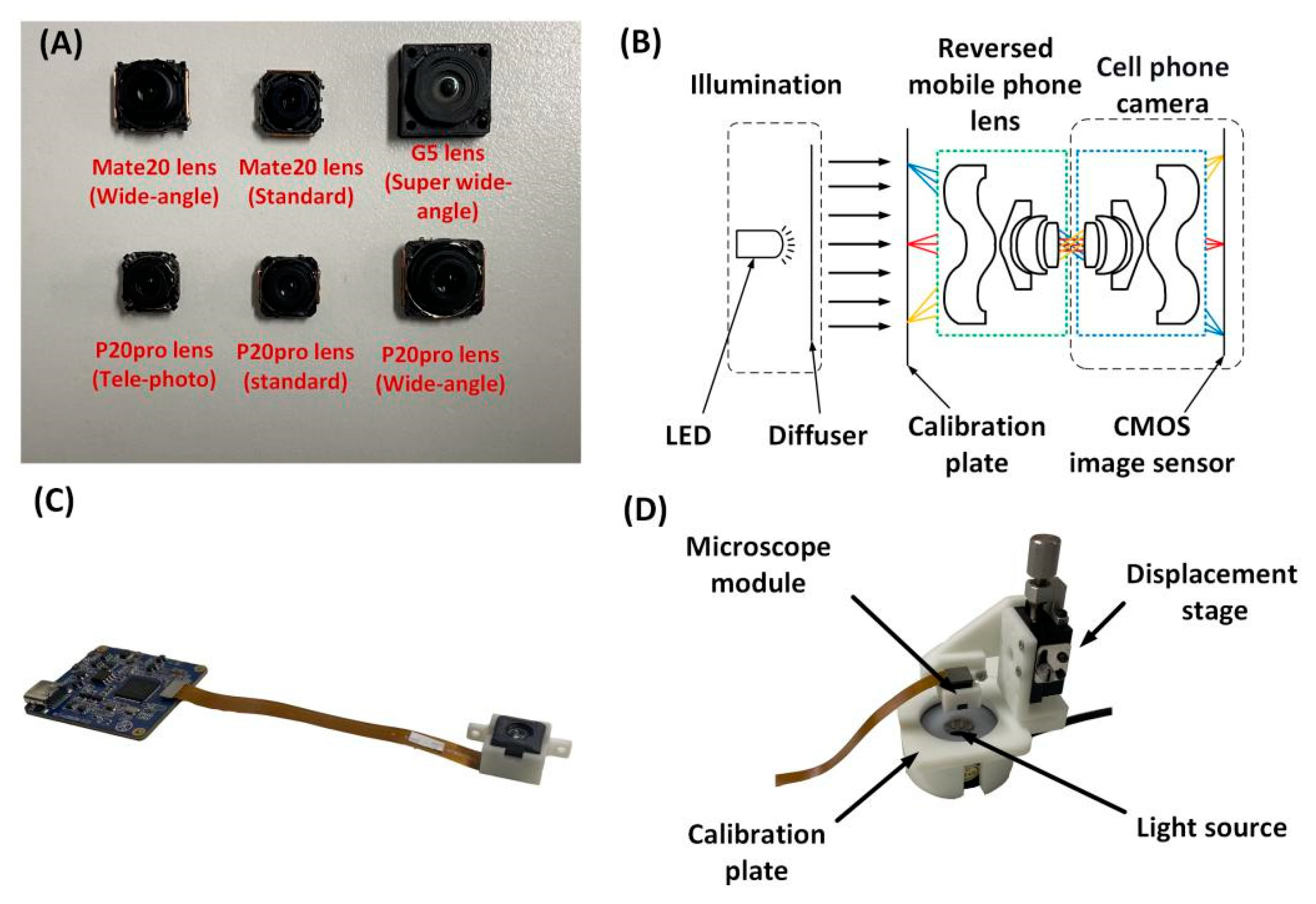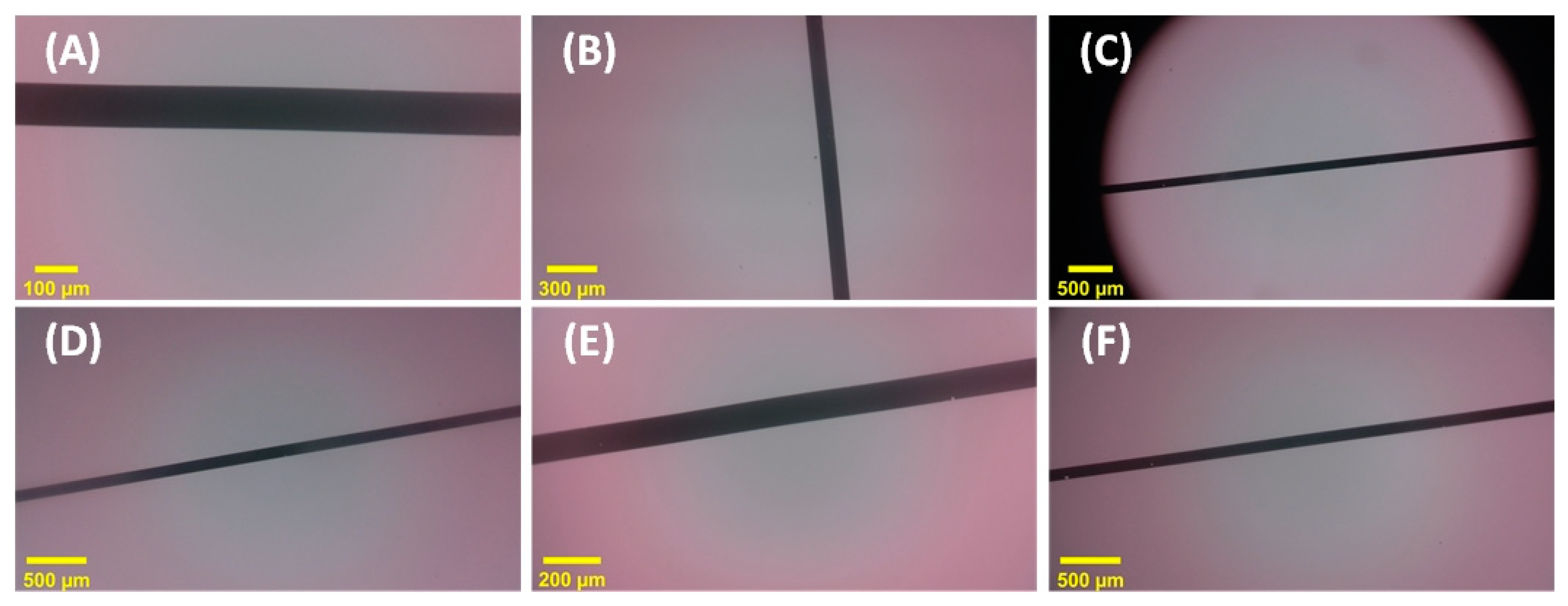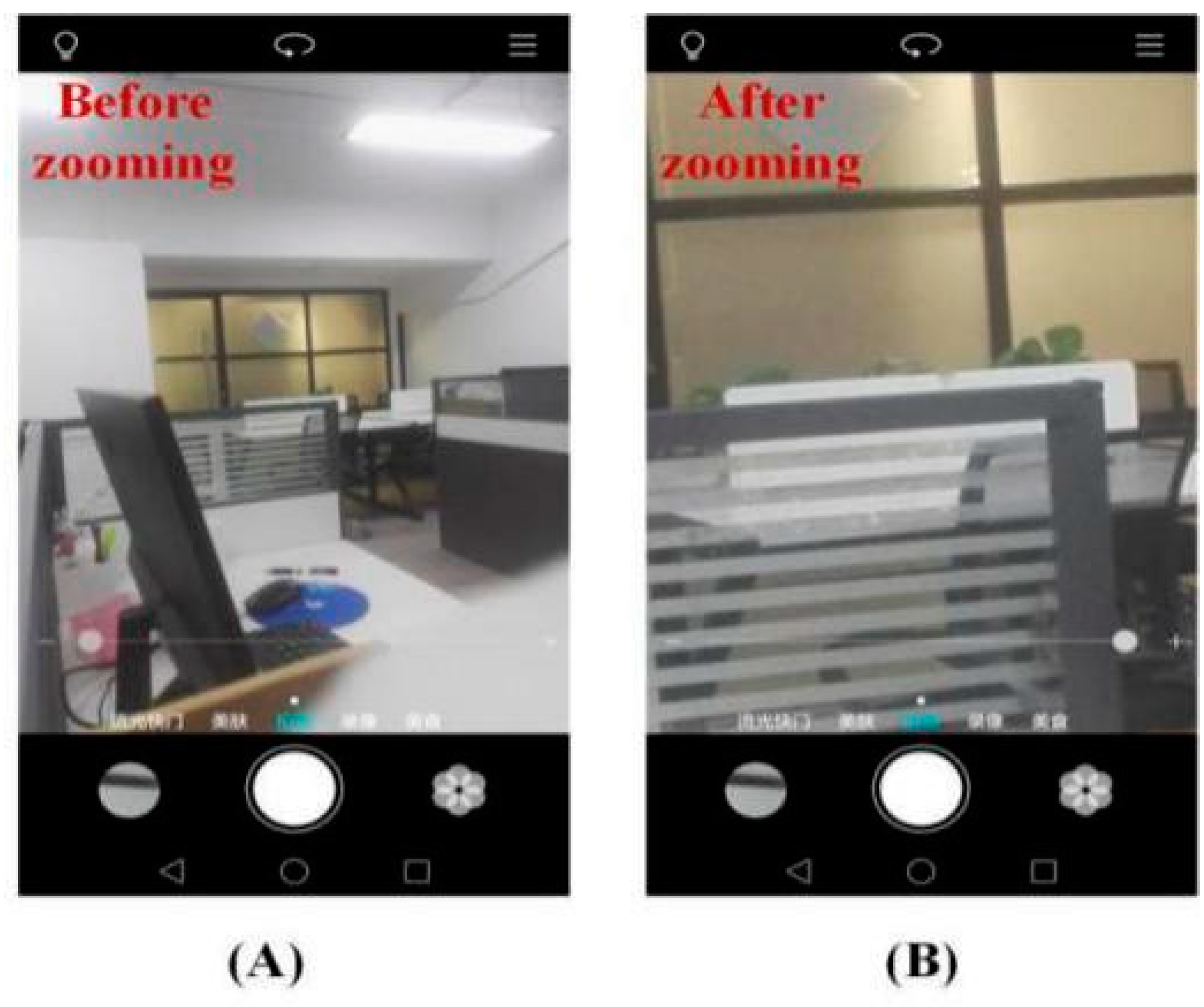Design of a Cell Phone Lens-Based Miniature Microscope with Configurable Magnification Ratio
Abstract
:1. Introduction
2. Materials and Methods
2.1. Principle of Miniature Cell Phone Microscope
2.2. Down-Selection of Different Effective Focal Length (EFL) Objectives
2.3. Assembly of Miniature Microscope with Switchable Magnification Ratios
3. Results
3.1. Microscopic Imaging Performance Tests
3.2. Real Sample Imaging Test
4. Discussions
5. Conclusions
Author Contributions
Funding
Institutional Review Board Statement
Informed Consent Statement
Data Availability Statement
Conflicts of Interest
References
- Schiffer, M.B.; Miller, A.R. The Material Life of Human Beings: Artifacts, Behavior, and Communication; Psychology Press: Hove, UK, 1999. [Google Scholar]
- Petti, C.A.; Polage, C.R.; Quinn, T.C.; Ronald, A.R.; Sande, M.A. Laboratory medicine in Africa: A barrier to effective health care. Clin. Infect. Dis. 2006, 42, 377–382. [Google Scholar] [CrossRef] [PubMed] [Green Version]
- Zheng, G.; Lee, S.A.; Yang, S.; Yang, C. Sub-pixel resolving optofluidic microscope for on-chip cell imaging. Lab. Chip 2010, 10, 3125–3129. [Google Scholar] [CrossRef] [PubMed] [Green Version]
- Bishara, W.; Su, T.W.; Coskun, A.F.; Ozcan, A. Lensfree on-chip microscopy over a wide field-of-view using pixel super-resolution. Opt. Express 2010, 18, 11181–11191. [Google Scholar] [CrossRef] [PubMed]
- Skandarajah, A.; Reber, C.D.; Switz, N.A.; Fletcher, D.A. Quantitative imaging with a mobile phone microscope. PLoS ONE 2017, 9, e96906. [Google Scholar] [CrossRef] [PubMed] [Green Version]
- Cai, F.; Wang, T.; Lu, W.; Zhang, X. High-resolution mobile bio-microscope with smartphone telephoto camera lens. Optik 2020, 207. [Google Scholar] [CrossRef]
- Breslauer, D.N.; Maamari, R.N.; Switz, N.A.; Lam, W.A.; Fletcher, D.A. Mobile phone based clinical microscopy for global health applications. PLoS ONE 2009, 4, e6320. [Google Scholar] [CrossRef] [PubMed]
- Smith, Z.J.; Chu, K.; Espenson, A.R.; Rahimzadeh, M.; Gryshuk, A.; Molinaro, M.; Dwyre, D.M.; Lane, S.; Matthews, D.; Wachsmann-Hogiu, S. Cell-phone-based platform for biomedical device development and education applications. PLoS ONE 2011, 6, e17150. [Google Scholar] [CrossRef] [PubMed]
- Switz, N.A.; D’Ambrosio, M.V.; Fletcher, D.A. Low-cost mobile phone microscopy with a reversed mobile phone camera lens. PLoS ONE 2014, 9, e95330. [Google Scholar] [CrossRef] [PubMed] [Green Version]
- McKay, G.N.; Mohan, N.; Butterworth, I.; Bourquard, A.; Sánchez-Ferro, Á.; Castro-González, C.; Durr, N.J. Visualization of blood cell contrast in nailfold capillaries with high-speed reverse lens mobile phone microscopy. Biomed. Opt. Express 2020, 11, 2268–2276. [Google Scholar] [CrossRef] [PubMed]
- Dong, S.; Guo, K.; Nanda, P.; Shiradkar, R.; Zheng, G. FPscope: A field-portable high-resolution microscope using a cellphone lens. Biomed. Opt. Express 2014, 5, 3305–3310. [Google Scholar] [CrossRef] [PubMed] [Green Version]
- Kim, J.-H.; Joo, H.-G.; Kim, T.-H.; Ju, Y.-G. A smartphone-based fluorescence microscope utilizing an external phone camera lens module. BioChip J. 2015, 9, 285–292. [Google Scholar] [CrossRef]
- Kim, K.M.; Choe, S.-H.; Ryu, J.-M.; Choi, H. Computation of Analytical Zoom Locus Using Padé Approximation. Mathematics 2020, 8, 581. [Google Scholar] [CrossRef] [Green Version]
- Chen, X.; Yu, L.; Kang, Q.; Sun, Y.; Huang, Y.; Shen, D. A smartphone-based absorbance device extended to ultraviolet (365 nm) and near infrared (780 nm) regions using ratiometric fluorescence measurement. Microchem. J. 2021, 164, 105978. [Google Scholar] [CrossRef]
- Goenka, C.; Lewis, W.; Chevres-Fernández, L.R.; Ortega-Martínez, A.; Ibarra-Silva, E.; Williams, M.; Franco, W. Mobile phone-based UV fluorescence microscopy for the identification of fungal pathogens. Lasers Surg. Med. 2019, 51, 201–207. [Google Scholar] [CrossRef] [PubMed]
- Diederich, B.; Wartmann, R.; Schadwinkel, H.; Heintzmann, R. Using machine-learning to optimize phase contrast in a low-cost cellphone microscope. PLoS ONE 2018, 13, e0192937. [Google Scholar] [CrossRef] [PubMed] [Green Version]
- Helmchen, F.; Fee, M.S.; Tank, D.W.; Denk, W. A miniature head-mounted two-photon microscope: High-resolution brain imaging in freely moving animals. Neuron 2001, 31, 903–912. [Google Scholar] [CrossRef] [Green Version]
- Rolland, J.P.; Fuchs, H. Optical versus video see-through head-mounted displays in medical visualization. Presence Teleoper. Virtual Environ. 2000, 9, 287–309. [Google Scholar] [CrossRef]
- Di Febo, R.; Casas, L.; Antonini, A. A smartphone-based petrographic microscope. Microsc. Res. Tech. 2021. [Google Scholar] [CrossRef] [PubMed]










| Camera Lens Source | Magnification Ratio | Focal Length (mm) | Camera Lens Source | Magnification Ratio | Focal Length (mm) |
|---|---|---|---|---|---|
| Mate20 (Wide-angle) | 2.4 | 2.5 | P20pro (Wide-angle) | 1.5 | 4.0 |
| Mate20 (Standard) | 1.2 | 5.0 | P20pro (Tele-photo) | 0.75 | 8.0 |
| G5 (Super wide-angle) | 3.9 | 1.5 | P20pro (Standard) | 1.0 | 6.0 |
| Before Zooming | After Zooming | Highest Resolution (lp/mm) | |||
|---|---|---|---|---|---|
| Magnification Ratio | FOV/um | Magnification Ratio | FOV/um | ||
| G5 (Super wide-angle) | 3.0 | 2137 × 1613 | 11.5 | 505 × 381 | 574.7 |
| P20pro (Wide-angle) | 1.2 | 4809 × 3629 | 4.9 | 1178 × 889 | 406.4 |
| P20pro (Standard) | 0.8 | 7213 × 5443 | 3.3 | 1749 × 1320 | 228.1 |
Publisher’s Note: MDPI stays neutral with regard to jurisdictional claims in published maps and institutional affiliations. |
© 2021 by the authors. Licensee MDPI, Basel, Switzerland. This article is an open access article distributed under the terms and conditions of the Creative Commons Attribution (CC BY) license (https://creativecommons.org/licenses/by/4.0/).
Share and Cite
Wan, X.; Tao, X. Design of a Cell Phone Lens-Based Miniature Microscope with Configurable Magnification Ratio. Appl. Sci. 2021, 11, 3392. https://doi.org/10.3390/app11083392
Wan X, Tao X. Design of a Cell Phone Lens-Based Miniature Microscope with Configurable Magnification Ratio. Applied Sciences. 2021; 11(8):3392. https://doi.org/10.3390/app11083392
Chicago/Turabian StyleWan, Xinjun, and Xuechen Tao. 2021. "Design of a Cell Phone Lens-Based Miniature Microscope with Configurable Magnification Ratio" Applied Sciences 11, no. 8: 3392. https://doi.org/10.3390/app11083392
APA StyleWan, X., & Tao, X. (2021). Design of a Cell Phone Lens-Based Miniature Microscope with Configurable Magnification Ratio. Applied Sciences, 11(8), 3392. https://doi.org/10.3390/app11083392





